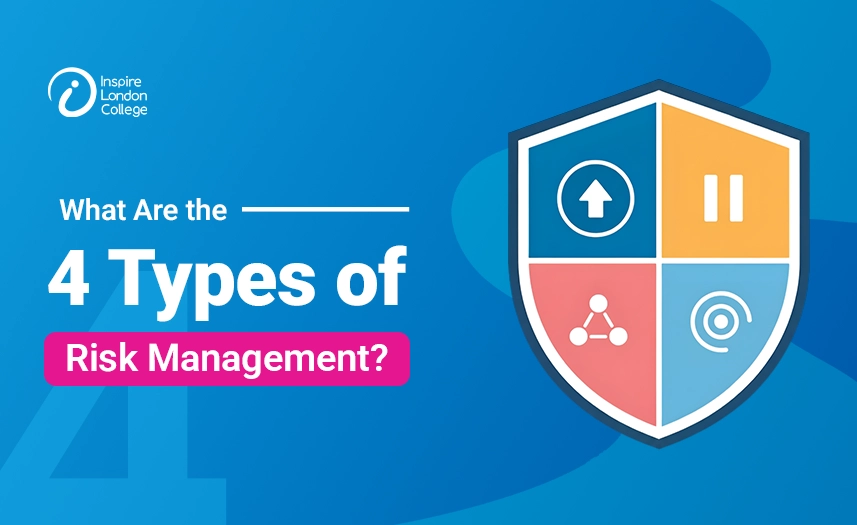Every decision, whether in business or daily life, involves some level of risk. Ignoring these risks might lead to financial losses, reputational damage, or missed opportunities.
That is why managing risk is more important than ever. When you take control of potential threats, you protect your assets, respond to challenges more effectively, and set the stage for long-term growth. By actively managing risk, you make room for smarter, more secure decisions that push you forward with confidence.
Let’s explore what are the 4 types of risk management in this article and how each one helps you stay ahead.
What is Risk Management?
Risk management starts with identifying possible problems, understanding how they might affect your goals, and taking smart steps to manage them. It plays a major role in helping businesses handle change and protect what matters most, such as money, people, and reputation. More importantly, risk management goes beyond avoiding trouble, it involves turning risks into new opportunities that support growth and providing valuable insights that guide better decisions.
Why is Risk Management Important for Businesses?
Businesses now treat risk management as a strategic tool rather than just a way to avoid problems. They actively include it in their planning and decision-making processes to stay competitive and prepared. Businesses can create a clear connection between what they want to achieve and how much risk they are willing to take by aligning strategies with their goals. This alignment allows them to turn risks into opportunities that bring innovation and support long-term growth.
As markets become more complex and unpredictable, companies rely on risk management to stay agile and focused. They also improve their chances of gaining revenue and protecting profits through smart risk practices. Whether it means saving money on cyber insurance, avoiding legal issues, or expanding into new markets, effective risk management makes these steps smoother and more successful.
What are 4 Strategies of Risk Management?
Handling risks the right way helps both businesses and individuals stay steady, even when things get uncertain. Using the main strategies of risk management makes it easier to protect what matters the most and spot chances to grow. So, let’s walk through what are the four types of risk management and see how they make a difference.
1. Risk Avoidance
Risk avoidance means identifying potential threats and removing the activities that could cause them. This type of risk management involves taking a proactive approach by helping businesses eliminate risks before they occur. Companies apply this strategy when the possible damage outweighs the benefits of continuing with a task. This method requires awareness, research, and the ability to change plans quickly. Businesses apply risk avoidance to follow laws, maintain reputation, and do long-term planning through better decision-making. Although risk avoidance may limit new opportunities, it offers strong security and stability.
2. Risk Reduction
Risk reduction means lowering the chance or the impact of a threat instead of removing it completely. This method works well when it’s not possible to eliminate a risk but steps can be taken to reduce its effects. Businesses improve processes, apply safety measures, and use technology to reduce harm. This type of risk management helps them stay in control during unexpected events and avoid major losses. Besides, risk reduction also allows better planning and preparation across teams.
3. Risk Sharing
Risk sharing involves spreading risk between the business and another party using agreements, insurance, or services. This is an effective strategy for both manufacturing and service provision businesses where certain aspects of operations can be contracted out to another company. This method allows businesses to focus on core tasks while experts handle specific risks. Clear contracts ensure both sides understand their duties. Strong teamwork and communication are essential in this regard to improve the outcome. When planned well, risk sharing increases business efficiency and security.
4. Risk Retention
Risk retention means accepting the risk and dealing with it when it happens, especially if it’s small or inexpensive to manage. Companies use this strategy when the cost of prevention is higher than the risk itself. Risk retention keeps operations flexible and saves resources for more serious threats. Retained risks are tracked to avoid unexpected damage. This method works best when businesses understand the risk and can manage it quickly. In addition, risk retention also supports faster decisions by avoiding over-planning and helps teams focus energy where it’s truly needed.
What Are the 4 Levels of Risk Management?
Understanding what are the 4 types of risk management is only part of the process. A structured approach to managing risks also involves several levels that provide a clear framework to tackle risks systematically. These levels of risk management are as follows:
- Identify: The first stage in any risk management strategy is identifying potential risks. This approach requires thorough analysis to uncover both visible and hidden risks
- Assess: Once risks are identified, they must be assessed for their potential impact and likelihood of occurring. This allows businesses to prioritise which risks to address first.
- Monitor: After assessing the risks, mitigation strategies can be implemented to reduce or eliminate their impact. This can include implementing new processes or improving existing ones.
- Report: Finally, continuous monitoring ensures that the risk management strategies remain effective. Regular updates help businesses adapt to changing conditions.
What Are the 4 M’s of Risk Management?
The 4 M’s of risk management is a framework that helps organisations identify and manage risks by focusing on four core areas including people, equipment, materials, and processes. This framework encourages teams to assess potential risks from every aspect, making it easier to prevent issues before they happen. The 4 M’s of risk management include:
1. Man
People play a crucial role in managing risks. Their actions, decisions, and level of training can directly affect outcomes. The chance of errors ultimately decreases when employees receive proper guidance and remain aware of safety practices. Providing regular training and promoting accountability builds a culture where people handle tasks carefully and responsibly.
2. Machine
Machines and tools used during operations can introduce risks if they malfunction or receive poor maintenance. Checking equipment regularly and following the right handling procedures can help businesses reduce this risk. Keeping machines in good condition ensures smooth operations and avoids unexpected breakdowns or safety hazards.
3. Material
Materials used in production or service delivery affect both quality and consistency. Using low-grade materials or facing supply delays can lead to poor results and unhappy customers. Choosing trusted suppliers, maintaining stock levels, and checking quality at every step help organisations manage this type of risk.
4. Method
Methods refer to the step-by-step processes that teams follow to complete tasks. Poorly planned or outdated methods can increase the chance of errors. Businesses strengthen risk control by reviewing processes often, making improvements, and ensuring everyone understands their role. Clear, efficient methods help teams perform better and safer.
Learn more about Risk Management with Inspire London College
If you are interested in gaining more knowledge about managing risk, OTHM Level 7 Diploma in Risk Management offered by Inspire London College helps you build real skills to handle risks confidently. This Ofqual qualification gives learners the tools they need to grow in their career and manage challenges more effectively. This online course is perfect for anyone looking to improve their knowledge and make smarter decisions in the workplace. Get certified now in risk management to gain better job opportunities.






